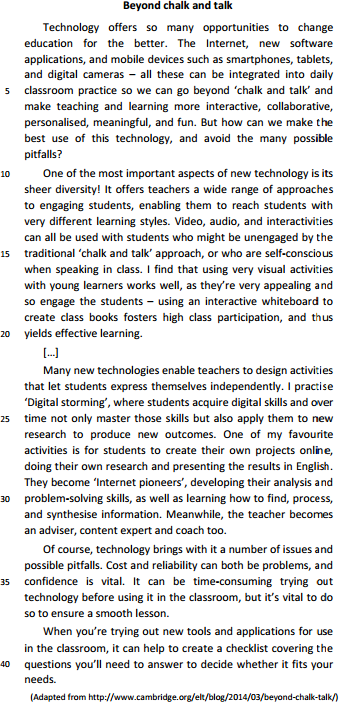Questões de Concurso
Sobre oposto | opposite em inglês
Foram encontradas 74 questões
According to the second paragraph, Finnish schools are very successful.
The opposite of the adjective SUCCESSFUL is:
For the question use the poem below:
Eating Poetry
(Mark Strand)
Available at: https://www.poetryfoundation.org/poems/52959/eating-poetry Accessed on December 30th, 2019.
“The light is dim.” The opposite of the underlined word is:
Based on the text, judge the following item.
“bad” in “reception was sometimes bad” (line 9) is not
the contrary of better.
Executive Secretary
We are looking for a competent Executive Secretary to support high-ranking officials in our company. You will be the one to organize and maintain the executive’s schedule and assist them by performing a variety of administrative tasks.
Executive secretaries must be quick professionals with great time-management and multitasking abilities. It is with their diligence and competence in their work that executives can focus on their managerial responsibilities without worrying for other tasks.
The goal is to contribute to the efficiency of the overall business by ensuring all assigned administrative duties are carried on timely and efficiently.
Responsibilities
• Maintain executive’s agenda and assist in planning appointments, board meetings, conferences, etc;
• Attend meetings and keep minutes;
• Receive and screen phone calls and redirect them when appropriate;
• Handle and prioritize all outgoing or incoming correspondence (e-mail, letters, packages etc.);
• Make travel arrangements for executives;
• Handle confidential documents ensuring they remain secure;
• Prepare invoices or financial statements and provide assistance in bookkeeping;
• Monitor office supplies and negotiate terms with suppliers to ensure the most cost-effective orders;
• Maintain electronic and paper records ensuring information is organized and easily accessible;
• Conduct research and prepare presentations or reports as assigned.
Requirements
• Proven experience as executive secretary or similar administrative role; Proficient in MS Office and “back-office” software (e.g. ERP);
• In depth knowledge of office management as well as technical vocabulary of relevant industry;
• Familiarity with basic research methods and reporting techniques;
• Excellent organizational and time-management skills;
• Outstanding communication and negotiation abilities;
• Integrity and confidentiality;
• Degree in business administration or relative field.
(Adapted from: https://resources.workable.com/executive-secretary-job-description)
Consider the following words from the text:
DILIGENCE – CARRIED ON – OVERALL
We can state that possible opposites for them are:
Read TEXT 3 and answer question.
TEXT 3
THE PAPERLESS CLASSROOM IS COMING
Michael Scherer
Back-to-school night this year in Mr. G’s sixth-grade classroom felt a bit like an inquisition.
Teacher Matthew Gudenius, a boyish, 36-year-old computer whiz who runs his class like a preteen tech startup, had prepared 26 PowerPoint slides filled with facts and footnotes to deflect the concerns of parents. But time was short, the worries were many, and it didn’t take long for the venting to begin.
“I like a paper book. I don’t like an e-book,” one father told him, as about 30 adults squeezed into a room for 22 students. Another dad said he could no longer help his son with homework because all the assignments were online. “I’m now kind of taking out of the routine.”, he complained. Rushing to finish, Gudenius passed a slide about the debate over teaching cursive, mumbling, “We don’t care about handwriting.” In a flash a mother objected: “Yeah, we do.”
At issue was far more than penmanship. The future of K-12 education is arriving fast, and it looks a lot like Mr. G’s classroom in the northern foothills of California’s wine country. Last year, President Obama announced a federal effort to get a laptop, tablet or smartphone into the hands of every student in every school in the U.S. and to pipe in enough bandwidth to get all 49.8 million American kids online simultaneously by 2017. Bulky textbooks will be replaced by flat screens. Worksheets will be stored in the cloud, not clunky Trapper Keepers. The Dewey decimal system will give way to Google. “This one is a big, big deal,” says Secretary of Education Arne Duncan.
It’s a deal Gudenius has been working to realize for years. He doesn’t just teach a computer on every student’s desk; he also tries to do it without any paper at all, saving, by his own estimate, 46,800 sheets a year, or about four trees. The paperless learning environment, while not the goals of most fledgling programs, represents the ultimate result of technology transforming classroom.
Gudenius started teaching as a computer-lab instructor, seeing students for just a few hours each month. That much time is still the norm for most kids. American schools have about 3.6 students for every classroom computing device, according to Education Market Research, and only 1 in 5 school buildings has the wiring to get all students online at once. But Gudenius always saw computers as a tool, not a subject. “We don’t have a paper-and-pencil lab, he says. When you are learning to be a mechanic, you don’t go to a wrench lab.”
Ask his students if they prefer the digital to the tree-based technology and everyone will say yes. It is not unusual for kids to groan when the bell rings because they don’t want to leave their work, which is often done in ways that were impossible just a few years ago. Instead of telling his students to show their work when they do an algebra equation, Gudenius asks them to create and narrate a video about the process, which can then be shown in class. History lessons are enlivened by brief videos that run on individual tablets. And spelling, grammar and vocabulary exercises have the feel of a game, with each student working at his own speed, until Gudenius – who tracks the kids’ progress on a smartphone – gives commands like “Spin it” to let the kids know to flip the screens of their devices around so that he can see their work and begin the next lesson.
Source: TIME- How to Eat Now. Education: The Paperless Classroom is Coming, p. 36-37; October 20, 2014

Mining tourism in Ouro Preto
Ouro Preto is surrounded by a rich and varied natural environment with waterfalls, hiking trails and native vegetation partially protected as state parks. Parts of these resources are used for tourism. Paradoxically, this ecosystem contrasts with the human occupation of the region that produced, after centuries, a rich history and a cultural connection to mining, its oldest economic activity which triggered occupation. The region has an unlimited potential for tourism, especially in specific segments such as mining heritage tourism, in association or not with the existing ecotourism market. In fact, in Ouro Preto, tourism, history, geology and mining are often hard to distinguish; such is the inter-relationship between these segments.
For centuries, a major problem of mining has been the reuse of the affected areas. Modern mining projects proposed solutions to this problem right from the initial stages of operation, which did not happen until recently. As a result, most quarries and other old mining areas that do not have an appropriate destination represent serious environmental problems. Mining tourism utilizing exhausted mines is a source of employment and income. Tourism activities may even contribute to the recovery of degraded areas in various ways, such as reforestation for leisure purposes, or their transformation into history museums where aspects of local mining are interpreted.
Minas Gerais, and particularly Ouro Preto, provides the strong and rich cultural and historical content needed for the transformation of mining remnants into attractive tourism products, especially when combined with the existing cultural tourism of the region. Although mining tourism is explored in various parts of the world in extremely different social, economic, cultural and natural contexts, in Brazil it is still not a strategy readily adopted as an alternative for areas affected by mining activities.
(Lohmann, G. M.; Flecha, A. C.; Knupp, M. E. C. G.; Liccardo, A. (2011). Mining tourism in Ouro Preto, Brazil: opportunities and challenges. In: M. V. Conlin; L. Jolliffe (eds).Mining heritage and tourism: a global synthesis. New York: Routledge, pp. 194-202.)
Read text II and answer the question:

In the sentence “these findings suggest that Facebook may undermine it” (l.32 and 33), the verb “undermine” means the opposite of the verb to mine.
The term “better” (l.18) is the opposite of worst.
Can I help reduce energy consumption?
We have an important role to play right now. Energy conservation helps a lot in preserving our planet’s rich natural resources and promoting a healthy environment. Here you will find simple things that you can do to help reduce energy consumption.
· Turn–off non-essential lights and appliances. The electricity generated by fossil fuels for a single home puts more carbon dioxide into the air than two average cars.
· Avoid turning on large appliances such as washers, dryers, and electric ovens during peak energy hours: from 5:00 am to 9:00 am and 4: pm to 7:00 pm.
· Install white window curtains to reflect heat away from the house. Close them at night to reduce the amount of heat lost through windows. People who live in countries that have warm climates should do this during the day as well.
· Turn off the lights in any room you are not using and consider installing timers, photo cells, or occupancy sensors to reduce the amount of time your lights are on.










